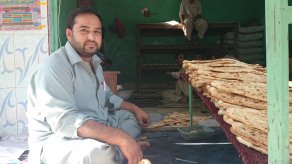
Photo: Arne Strand, CMI
Many asylum seekers who choose assisted return are from a country destroyed by war and conflict. More than half of those who return to countries such as Afghanistan and Iraq plan to migrate again. Assisted return is a viable type of support to assist with the return, but is not sufficient to prevent large numbers of people once again leaving insecure countries of return. Only minor changes are required, however, to increase the potential for permanent return.
One important political objective in Norway is to encourage asylum seekers who do not have a valid residence permit to return to their country of origin. To this end, a major initiative is for the Norwegian Government to offer support for assisted return. In 2015, approximately 1,200 persons accepted the offer. This involves practical assistance with the application process and with the journey back to the country of origin. On arrival, the persons who have accepted assisted return receive financial support with a cash payment. They also receive support in the form of various reintegration measures in some countries. An evaluation – initiated by the Norwegian Directorate of Immigration and conducted by the CMI, PRIO and the Institute for Social Research – focused on Kosovo, where persons who chose assisted return received financial support only, and on three specially developed programmes for Afghanistan, Iraq and Ethiopia. In Afghanistan and Iraq, the financial support is administered by the International Organisation for Migration (IOM), whereas a separate governmental body has been set up for this purpose in Ethiopia. The results of the evaluation are based on personal interviews with 79 persons who returned to these countries, supplemented by telephone interviews.
Many choose to leave again
The responses during the interviews paint a clear picture. The return programme is successful in parts: the assistance provided in Norway, the actual return journey and the cash payment received upon arrival in their country of origin works well. The problems start when the persons who return home have to choose between different types of reintegration assistance. In this instance, these measures include starting their own business, job placement or education. Most choose – or are advised to choose – starting their own business.
This can be a sensible choice in a country such as Ethiopia, currently experiencing strong economic growth. However, in countries suffering from a high level of conflict and poor economy, such as Afghanistan and Iraqi Kurdistan, most do not succeed. Permanent return becomes problematic when asylum seekers who have returned home struggle to make a living. Many feel insecure about their future and a total 40% of the interviewees in these four countries stated that they plan to migrate again. More than half of those who returned to Afghanistan and Iraqi Kurdistan aim to leave their home country again.
Minor changes may help increase the permanence of assisted return
In many examples, assisted return would have been more permanent if the persons involved had been able to find work or a source of income. Minor changes to the current return scheme could have a major impact, without necessarily costing too much.
In general, those who return home can be divided into four categories.
- At one outer extreme are those who both want to and are able to achieve a permanent reintegration in their home country.
- On the opposite extreme are those who have no plans to remain, but aim to leave again.
These two extremes will extensively exploit the support provided via the return programme to achieve their goals.
- In between the two extremes are all those who aim for reintegration but fail, and
- those who hope to leave again but are not able to.
For both these groups, assisted return and the success of the programme have a decisive influence on whether they are able to gain an income and decide to remain in their country of origin.
The evaluation shows that those who return home have in general a need for better advice and more guidance than that currently offered. This is particularly true in relation to whether they choose to start their own business, accept job placement or education, and in relation to how they manage the support they receive. Individual backgrounds and other factors also influence the need for assistance. Persons who have been away from their home country for a long time require more advice, and those who only have a small or non-existent network need more follow-up. For many people, starting their own business is not a good solution, particularly for those with low reading and writing proficiency. The programmes involving job placement or vocational training are much less popular but could qualify such persons for employment and provide them with the opportunity to find work and earn a higher salary. As such, these represent a much better alternative.
Being able to trust the organisations that manage support is another important factor for the success of assisted return. In Norway, rumours of corruption within the IOM have made many sceptical about choosing assisted return. Many have been afraid they will not receive the reintegration support they have been promised.
Assisted return is of value for those who have returned to their country of origin. However, the programme can be improved and made more permanent by ensuring that it is reliable and by providing better guidance and follow-up. It will always be more of a challenge to ensure permanent return of asylum seekers to countries and areas suffering from conflict and a poor economy. This must be taken into account when providing information on assisted return in Norway and when recommending the type of support to be chosen to those who have returned.